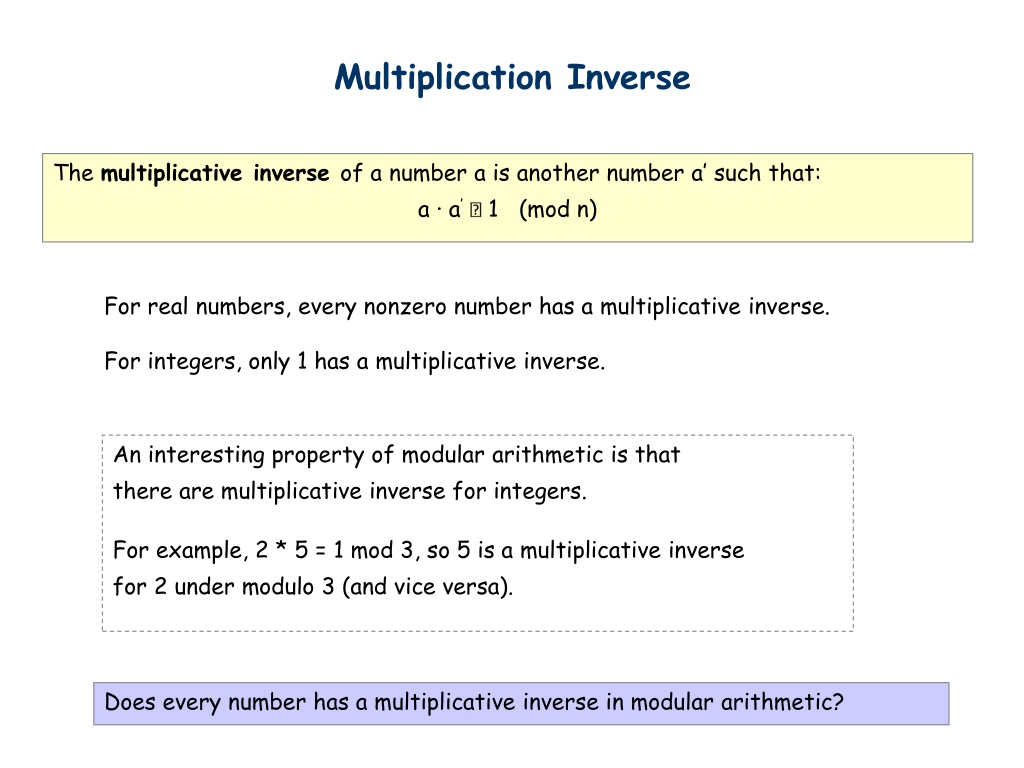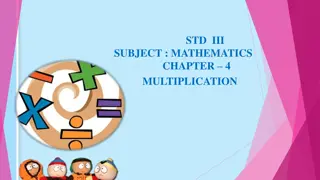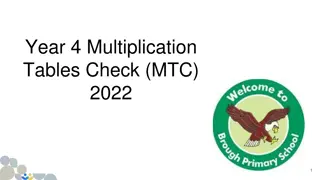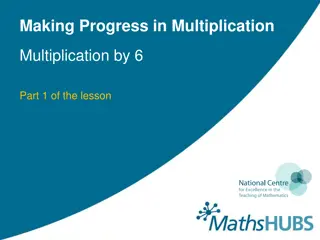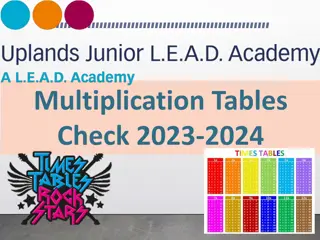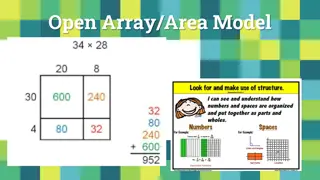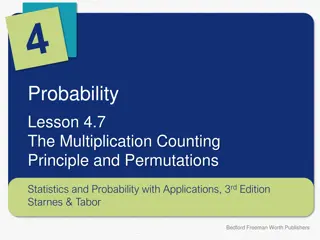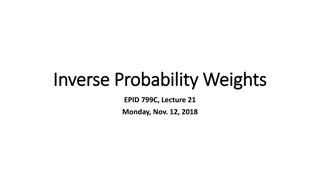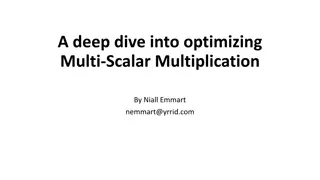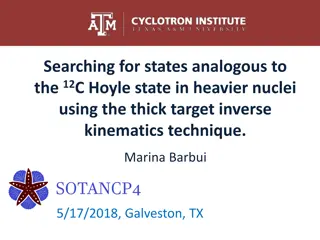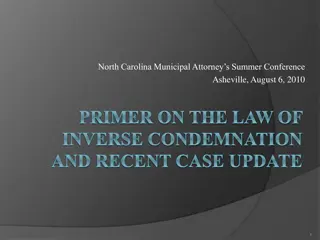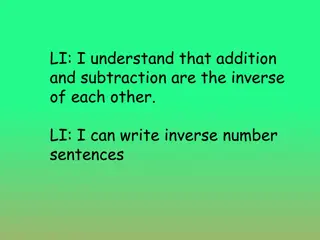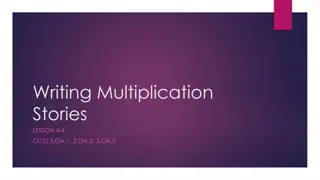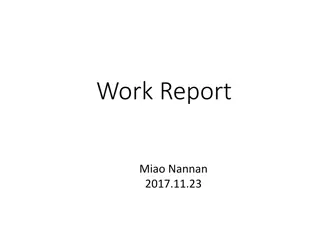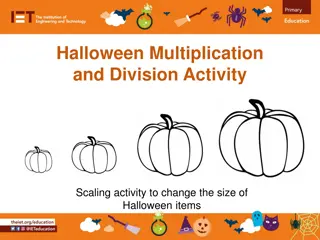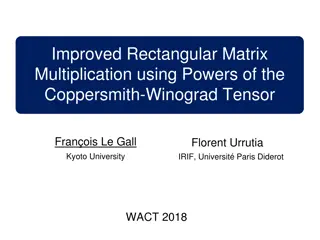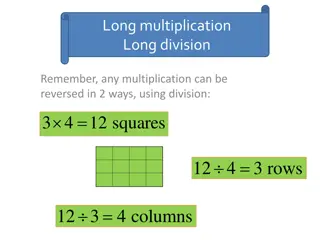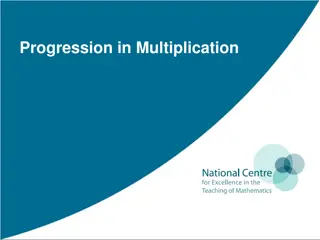Multiplication Inverse
The concept of multiplicative inverses in modular arithmetic, exploring the conditions where numbers have multiplicative inverses, and investigating the necessary and sufficient conditions for a number to have a multiplicative inverse modulo another number.
Download Presentation

Please find below an Image/Link to download the presentation.
The content on the website is provided AS IS for your information and personal use only. It may not be sold, licensed, or shared on other websites without obtaining consent from the author.If you encounter any issues during the download, it is possible that the publisher has removed the file from their server.
You are allowed to download the files provided on this website for personal or commercial use, subject to the condition that they are used lawfully. All files are the property of their respective owners.
The content on the website is provided AS IS for your information and personal use only. It may not be sold, licensed, or shared on other websites without obtaining consent from the author.
E N D
Presentation Transcript
Multiplication Inverse The multiplicative inverse of a number a is another number a such that: a a 1 (mod n) For real numbers, every nonzero number has a multiplicative inverse. For integers, only 1 has a multiplicative inverse. An interesting property of modular arithmetic is that there are multiplicative inverse for integers. For example, 2 * 5 = 1 mod 3, so 5 is a multiplicative inverse for 2 under modulo 3 (and vice versa). Does every number has a multiplicative inverse in modular arithmetic?
Multiplication Inverse Does every number has a multiplicative inverse in modular arithmetic?
Multiplication Inverse What is the pattern?
Case Study Why 2 does not have a multiplicative inverse under modulo 6? Suppose it has a multiplicative inverse y. 2y 1 (mod 6) => 2y = 1 + 6x for some integer x => y = + 3x This is a contradiction since both x and y are integers.
Necessary Condition Claim. An integer k does not have an multiplicative inverse under modulo n, if k and n have a common factor >= 2 (gcd(k,n) >= 2). Proof. Suppose, by contradiction, that there is an inverse k for k such that k k = 1 (mod n) Then k k = 1 + xn for some integer x. Since both k and n have a common factor, say c>=2, then k=ck1and n=cn1for some integers k1and n1. So k ck1= 1 + xcn1. Then k k1= 1/c + xn1 This is a contradiction since the LHS is an integer but the RHS is not. This claim says that for k to have a multiplicative inverse modulo n, then a necessary condition is that k and n do not have a common factor >= 2.
Sufficient Condition What about if gcd(k,n)=1? Would k always have an multiplicative inverse under modulo n? 3 5 1 (mod 7) For example, gcd(3,7) = 1 4 3 1 (mod 11) gcd(4,11) = 1 8 8 1 (mod 9) gcd(8,9) = 1 It seems that there is always an inverse in such a case, but why? gcd(8,9) = 1 8s + 9t = 1 for some integers s and t 8s = 1 9t gcd(8,9) = spc(8,9) 8s 1 (mod 9)
Sufficient Condition Theorem. If gcd(k,n)=1, then have k such that k k 1 (mod n). gcd(k,n)=spc(k,n) Proof: Since gcd(k,n)=1, there exist s and t so that sk + tn = 1. So tn = 1 - sk This means n | 1 sk. This means that 1 sk 0 (mod n). This means that 1 sk (mod n). So k = s is an multiplicative inverse for k. The multiplicative inverse can be computed by the extended Euclidean algorithm. Corollary: k has a multiplicative inverse mod n if and only if gcd(k,n)=1
This Lecture Multiplicative inverse Cancellation in modular arithmetic Application: check digit scheme Fermat s little theorem
Cancellation Note that (mod n) is very similar to =. If a b (mod n), then a+c b+c (mod n). If a b (mod n), then ac bc (mod n) However, if ac it is not necessarily true that a bc (mod n), b (mod n). For example, 4 2 1 2 (mod 6), but 4 1 (mod 6) 3 4 1 4 (mod 8), but 3 1 (mod 8) 4 3 1 3 (mod 9), but 4 1 (mod 9) There is no general cancellation in modular arithmetic. Observation: In all the above examples c and n have a common factor.
Cancellation Why a k b k (mod n) when a b? Without loss of generality, assume 0 < a < n and 0 < b < n. Because if a k b k (mod n), then also (a mod n) k (b mod n) k (mod n). smaller than n. This means that ak = bk + nx. This means that (a-b)k = nx, which means a-b=(nx)/k. Since 0 < a < n and 0 < b < n, it implies that n < a-b < n. Therefore, nx/k must be < n. For this to happen, n and k must have a common divisor >= 2! Okay, so, can we say something when gcd(n,k)=1?
Cancellation Claim: Assume gcd(k,n) = 1. If i k j k (mod n), then i j (mod n). For example, multiplicative inverse always exists if n is a prime! Since gcd(k,n) = 1, there exists k such that kk 1 (mod n). Proof. i k j k (mod n). => i k k j k k (mod n). => i j (mod n) Remarks (Optional): This makes arithmetic modulo prime a field, a structure that behaves like real numbers. Arithmetic modulo prime is very useful in coding theory.
This Lecture Multiplicative inverse Cancellation in modular arithmetic Application: check digit scheme US Postal Money Order Airline Ticket ISBN Fermat s little theorem
Check Digit Scheme In many identification numbers, there is a check digit appended at the end. The purpose of this check digit is to detect errors (e.g. transmission error). For example, consider your HKID card number M123456(X). You want to have the check digit X to detect typos. Typical typos are: single digit 123456 123356 transposition 123456 124356 We want to design check digit scheme (a formula to compute X) so that these two types of errors can always be detected. It turns out that some simple modular arithmetic can do the trick.
US Postal Money Order The last digit is the check digit, and it is computed by the following formula: a11= (a1+ a2+ a3+ + a8+ a9+ a10) mod 9 In the above example, 1 = (1 + 6 + 4 + 2 + 0 + 6 + 9 + 0 + 3 + 6) mod 9 You can use this formula to generate the check digit.
US Postal Money Order a11= a1+ a2+ a3+ + a8+ a9+ a10(mod 9) Can it be used to detect single digit error? Correct number 27914009534 27914009534 Incorrect number 27914009834 27014009534 In the first case, (2 + 7 + 9 + 1 + 4 + 0 + 0 + 9 + 8 + 3) mod 9 = 43 mod 9 = 7 and the error is detected. But in the second case, (2+7+0+1+4+0+0+9+8+3) mod 9 = 31 mod 9 = 4 and the error is not detected.
US Postal Money Order a11= a1+ a2+ a3+ + a8+ a9+ a10(mod 9) Can it be used to detect single digit error? Correct number a1a2a3 a10a11 Incorrect number b1a2a3 a10a11 To be able to detect the error, we want a1+ a2+ a3+ + a8+ a9+ a10(mod 9) b1+ a2+ a3+ + a8+ a9+ a10(mod 9) This happens if and only if a1(mod 9) b1(mod 9) So it cannot detect the error exactly when a1(mod 9) = b1(mod 9)
US Postal Money Order a11= a1+ a2+ a3+ + a8+ a9+ a10(mod 9) Can it be used to detect transposition error? Correct number a1a2a3 a10a11 Incorrect number a2a1a3 a10a11 To be able to detect the error, we want a1+ a2+ a3+ + a8+ a9+ a10(mod 9) a2+ a1+ a3+ + a8+ a9+ a10(mod 9) This will never happen because the two sums are always the same.
US Postal Money Order The last digit is the check digit, and it is computed by the following formula: a11= a1+ a2+ a3+ + a8+ a9+ a10(mod 9) Except when ai(mod 9) = bi(mod 9) Can it be used to detect single digit error? Can it be used to detect transposition error? Never, except possibly the error is not the check digit
This Lecture Multiplicative inverse Cancellation in modular arithmetic Application: check digit scheme US Postal Money Order Airline Ticket ISBN Fermat s little theorem
Airline Ticket Identification Number The last digit is the check digit, and it is computed by the following formula: a15= a1a2a3 a13a14(mod 7) For example, consider the ticket number 0-001-1300696719-4 The check digit is 4, since 00011300696719 = 11300696719 = 1614385245 7 + 4
Airline Ticket Identification Number a15= a1a2a3 a13a14(mod 7) Can it be used to detect single digit error? Correct number a1a2 ai a13a14 Incorrect number a1a2 bi a13a14 The error is not detected if and only if a1a2 ai a13a14 a1a2 bi a13a14 (mod 7) if and only if a1a2 ai a13a14 - a1a2 bi a13a14 0 (mod 7) if and only if ai1014-i- bi1014-i if and only if ai - bi 0 (mod 7) if and only if ai bi (mod 7) 0 (mod 7) since 7 does not divide 10
Airline Ticket Identification Number a15= a1a2a3 a13a14(mod 7) Can it be used to detect transposition error? Correct number a1a2 cd a13a14 Incorrect number a1a2 dc a13a14 The error is not detected if and only if a1a2 cd a13a14 a1a2 dc a13a14 (mod 7) if and only if a1a2 cd a13a14 - a1a2 dc a13a14 0 (mod 7) if and only if (c10j+1+ d10j) (d10j+1+ c10j) if and only if c10j(10-1) - d10j(10-1) if and only if 9 10j(c-d) if and only if c d(mod 7) since 7 does not divide 9 and 7 does not divide 10 0 (mod 7) 0 (mod 7) 0 (mod 7)
Airline Ticket Identification Number The last digit is the check digit, and it is computed by the following formula: a15= a1a2a3 a13a14(mod 7) Except when ai(mod 7) = bi(mod 7) Can it be used to detect single digit error? Can it be used to detect transposition error? Except when c (mod 7) = d (mod 7)
This Lecture Multiplicative inverse Cancellation in modular arithmetic Application: check digit scheme US Postal Money Order Airline Ticket ISBN Fermat s little theorem
International Standard Book Number The last digit is the check digit, and it satisfies the following equation: 10a1+ 9a2+ 8a3+ 7a4+ 6a5+ 5a6+ 4a7+ 3a8+ 2a9+ a10 0 (mod 11) Note: When the check digit is 10, it assigns a10the special symbol X.
International Standard Book Number 10a1+ 9a2+ 8a3+ 7a4+ 6a5+ 5a6+ 4a7+ 3a8+ 2a9+ a10 0 (mod 11) Can it be used to detect single digit error? Correct number a1a2 ai a9a10 Incorrect number a1a2 bi a9a10 The error is not detected if and only if 10a1+ 9 102 +(11-i)ai +2 a9+a10 10a1+ 9 102 +(11-i)bi +a10 (mod 11) if and only if (11-i)ai (11-i)bi(mod 11) if and only if ai bi(mod 11) since gcd(11-i,11)=1 and so we can cancel (Another way to see it is to multiply the multiplicative inverse of (11-i) on both sides.) This happens only when ai = bi, in which case there is no error!
International Standard Book Number 10a1+ 9a2+ 8a3+ 7a4+ 6a5+ 5a6+ 4a7+ 3a8+ 2a9+ a10 0 (mod 11) Can it be used to detect transposition error? Correct number a1a2 cd a9a10 Incorrect number a1a2 dc a9a10 The error is not detected if and only if 10a1+ + (11-i-1)c + (11-i)d + +a10 10a1+ + (11-i-1)d + (11-i)c + +a10 (mod 11) if and only if (11-i-1)(c-d) + (11-i)(d-c) if and only if c-d 0 (mod 11) 0 (mod 11) This happens only when c = d, in which case there is no error!
International Standard Book Number The last digit is the check digit, and it satisfies the following equation: 10a1+ 9a2+ 8a3+ 7a4+ 6a5+ 5a6+ 4a7+ 3a8+ 2a9+ a10 0 (mod 11) Note: When the check digit is 10, it assigns a10the special symbol X. Can it be used to detect single digit error? Yes, always. Can it be used to detect transposition error? Yes, always.
